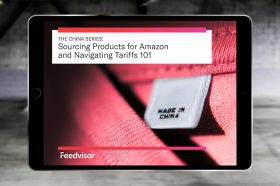Resources - Blog
How to Optimize Your Sourcing Strategy to Drive ROI on Amazon [Webinar Recap]

Stay on top of the latest e-commerce and marketplace trends.
Touting competitive prices and large-scale production capabilities, sourcing products from China, or elsewhere overseas, has become increasingly popular among brands and retailers operating on Amazon.
In 2018, U.S. imports from China totaled nearly $540 billion, up 60% over the last 10 years.
Many of these imports are goods sourced by Amazon merchants seeking innovative products or private label lines who leverage the Chinese supplier and manufacturer market for the value they can achieve through a mutually beneficial partnership.
Indeed, there are numerous advantages to sourcing your products overseas. However, the process requires time and thorough vetting to ensure satisfaction with the final product, price quotation, payment terms, and more. Particularly when sourcing from countries overseas, there are several logistical, cultural, and financial complexities that must be considered.
In this webinar, Sourcing Overseas: Expert Tips to Maximize Value and ROI on Amazon, Zack Leonard — founder of Gembah and expert in product sourcing, manufacturing, and design innovation — breaks down the steps to finding a competitive factory overseas and negotiating terms with your manufacturer, strategies for optimizing your supply chain to reduce costs, and ways to increase revenue through incremental product innovation.
Finding the Right Supplier
The first step to optimizing your sourcing strategy is to find the right supplier and develop a relationship beyond your existing or prospective business partnership. When sourcing from China, for instance, understanding “guanxi” — the fundamental dynamic of relationships in Chinese culture — is crucial to developing trust and value in your partnership.
Visit the country from which you are sourcing or looking to source your products and spend time face-to-face with your supplier. They truly value your efforts to visit their factory and understand how they do business, and they will appreciate even further any effort to understand their culture and offer your respects, such as sending warm wishes or a thoughtful gift on Chinese New Year.
Taking the extra step to building a relationship with your supplier will benefit both you and your business, as it will allow you more flexibility during negotiations like payments and boost confidence in the quality and success of your operation.
Visiting your supplier and the production factory is crucial to vetting and verifying what your supplier says and what the reality is. When vetting your supplier, consider the following questions:
- Who are they currently doing business with? Find out if they work with other big box retailers or other Amazon sellers. Are they selling on Amazon themselves?
- Have they exported goods before? You can fact-check this on websites like importgenius.com to confirm whether they have shipped product to the country from which you are selling.
- Do they have compliance documentation? Be sure that your supplier has some sort of third-party testing company to ensure quality control.
- What is their production capacity? Can they handle your production needs? Be sure to have a clear understanding of what is outsourced versus what they actually make in house and whether your supplier will be able to support your production needs as you scale.
- Are they currently in production? A busy factory is usually a good factory. If they are not currently in production, that could be a sign that they are not a major, competitive factory.
- Are they making products similar to yours? If you are looking to produce backpacks but see that the factory is manufacturing shoes, for example, then that factory is likely the wrong factory for your needs.
- How many people are working there? Who is the owner? Are there managers overseeing production? Be sure the factory is abiding by child labor laws and safety regulations.
What to Look for in a Price Quote
After you have vetted your supplier and are ready to move forward with a partnership, the next step is to ask for a price quote, which will require a thorough review while paying close attention to detail.
To the supplier, a price quote is equivalent to a contract, so details around the sample price, payment terms, and production schedule are crucial. Are there specified ramifications if something goes wrong and they fall behind the production schedule? All of this should be reflected in a comprehensive price quote.
At the minimum, your price quote should include:
- A breakdown of each component of your product and their cost
- Clearly defined payment terms
- The lead time, sample time, and sample cost as well as the mold fee
- Additional details such as ramifications
All of these details in your price quote are negotiable, so be sure to understand when you have leverage to negotiate pricing or sample fees. However, you must also be cautious and avoid making too bold of demands before you have established credit history with your supplier. Once you have started paying on time, you will have more leverage for negotiations.
Inject Quality Control
To ensure consistent quality and the supplier’s accountability, it is important to utilize a third-party quality control company with every factory you do business with. A low star rating on Amazon can take weeks of your time to correct.
Certainly, you can quantify the value of your time beyond $500 per hour, and for that cost, instead of spending the time to combat low star reviews yourself, you can use a third-party quality control company to do a complete inspection of your product on every single one of your production runs. This will also help to prevent quality fade, which can occur later on in a partnership when, after having developed trust, the manufacturer starts to cut corners to reduce its own costs.
The value of third-party quality control will prove to be immeasurable. Given that search rankings are largely impacted by ratings, proactively avoiding quality fade and holding your supplier accountable through your terms of agreement will, in the long term, help drive sales and prevent the potential decline of your search rank due to low ratings.
Add Value by Increasing Revenue
Once you have established terms with your supplier that reduce your costs, you can further add value to your Amazon business through product innovation. There are three ways in which this can be accomplished:
-
- White Labeling: This allows you to expand your brand without having to spend time and money designing new products.
- Incremental Innovation: Innovating within an existing product category allows you to use consumer feedback data to design according to their needs.
- New Product: Creating new products allows you to carve out new space in the market. You can defend your place in the market by patenting and trademarking these new items.
Of these three options, incrementally innovating within an existing product category often proves to be the most beneficial solution for long-term growth. Leverage search terms and sales data to identify the demand and opportunities within a product category and pinpoint areas of that product that can be optimized to provide an enhanced customer experience.
For example, the cooler company Yeti took a product that was already in demand and optimized the source materials to create a premium product that yields both customer loyalty and improved margins. By taking an existing product and enhancing its usability with higher-quality materials and engineering, despite having the same general design, the company has been able to capitalize on an existing consumer demand while outpacing its competitors and increasing its bottom line.
Customer reviews serve as a great source of inspiration for a product redesign. Take notice of customers who are using the product and pinpoint areas that can be optimized to better meet their needs. This will not only benefit your bottom line but also your customer loyalty, as consumers will see that you care about their input.
Learn what Feedvisor can do for your business.
When you partner with Feedvisor, you automatically receive access to our true, AI-driven technology and hands-on team of e-commerce experts. Contact one of our team members today to learn more about our end-to-end solution for brands and large sellers on Amazon, Walmart, and e-marketplaces.




